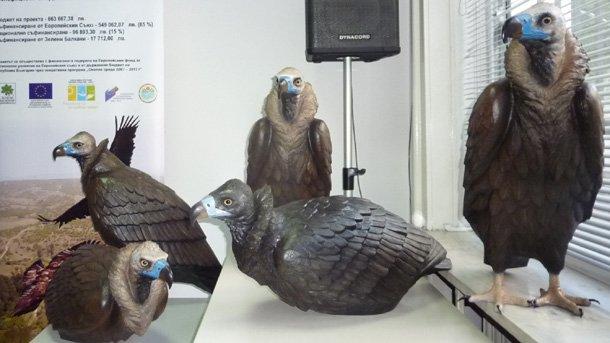
Several environmental NGOs in Bulgaria are now working on projects for the conservation of rare and valuable birds of prey in Europe, including several vulture species as well as imperial eagles and lesser kestrels. More than a hundred griffon vultures were brought from Spain under one of these projects implemented by Green Balkans, a federation of nature-conservation NGOs. After being kept indoors for several months for easier adaptation, thirty of them were set free at the end of October in different localities in the Balkan range.
In today’s program, we will tell you about another project of Green Balkans that has been the first of its kind in Europe so far – it is about using artificial but high-quality models of the black vultures for stimulating the nesting of this species in Bulgaria.
The Eurasian Black Vulture (also known as the Cinereous Vulture, or the Monk Vulture) was considered an extinct species in Bulgaria until 1993 when one pair of vultures was spotted nesting near Studen Kladenetz reservoir in the Eastern Rhodope Mountain. However, this remained the only pair with its permanent habitat there despite the hard efforts of environmentalists to create deliberate feeding schemes for the black vultures coming from Greece and thus make them stay permanently. Simeon Marin, leader of the project, told Radio Bulgaria more:
“We really have a pair of black vultures inhabiting the region of Studen Kladenetz reservoir. Another three to five birds arrive to look for food there. We regularly watch five birds with wing tags (special tracing devices for birds) and we came to the conclusion that they have already started permanently looking for food in the Eastern Rhodope Mountain. Of course, sometimes larger groups of birds gather at one place, 20, 30 or 40 birds at a time, but this seldom happens. Black vultures and other vulture species are perfectly capable of flying up to 100 km, even 150 km per day in search for food. So the occasional gathering of a large number of birds at one place is not necessarily a sign of success. What is important to us is the number of birds that permanently stay in one habitat.”
In order to attract more black vultures and imperial eagles, Green Balkans have started creating special sites for artificial nests. The results were extremely good for imperial eagles, but not for black vultures, Simeon Marinov says and adds:
“Three out of nine artificial nests for imperial eagles have been occupied during the first year. This is an extremely high success rate – one third of the nests occupied during the very first year. In Hungary, a similar thing was done but there the percentage of occupied nests is 5 to 10 percent, as they have placed 150 nests. We calculate more carefully where to place the nests. We have placed only three nests for the black vulture. They are put in regions with more difficult access, with no roads in a 2 km distance from the nests in order not to disturb the birds in the breeding season. So, we have to walk for at least two kilometers to reach the place, carrying all necessary equipment on our backs. Then, we climb the tallest trees to place the nests that reach 3 meters in diameter”.
So far, however, no black vultures have settled in these nests. Thus, a new idea was born, and namely to use high-quality artificial models of black vultures as bait. The artificial birds have been made by a sculptor who is also a trained ornithologist, hence their excellent making. The method has already been used to great success in Europe with some waterfowl species, but never with bird of prey.
“We will build more artificial nests in which we will place the artificial birds in different postures, perched, lying, brooding, and we have also put a newly-hatched bird. Now we can only wait and see what happens.”
Our goal in using artificial birds is to create the image and feeling of a whole colony of birds existing there and thus attract new birds to settle, Simeon Marin explains.
“Black vultures do not like to nest in numerous colonies, and sometimes their nests are situated at a distance of 2 km from one another, with the smallest distance being 300 meters. Their colonies cover a rather large area. For example, in neighboring Greece, a colony of 20 pairs of vultures is scattered over an area of 42 thousand hectares. The question is that in order to settle and start nesting, these birds need to have a stimulus, i.e. to see that some other birds have already settled there. In fact, science still doesn’t know exactly how many artificial birds need to have in order to attract new nesting pairs of vultures”, Simeon Marin, leader of the project, told Radio Bulgaria.
At the end of the summer and the start of the autumn, the five artificial models of black vultures were placed on the special feeding site allocated for this species in the Rhodope Mountain. The reaction has been assessed as positive as the artificial birds have not scared real vultures. Whether they attract them, however, is still hard to determine. The team of Green Balkans federation is now working on placing the artificial birds in the already existing three artificial nests for black vultures. The results will be expected in the coming spring.
Translated by: Rossitsa Petcova
По публикацията работи: Maria Dimitrova
Последвайте ни и в
Google News Showcase, за да научите най-важното от деня!